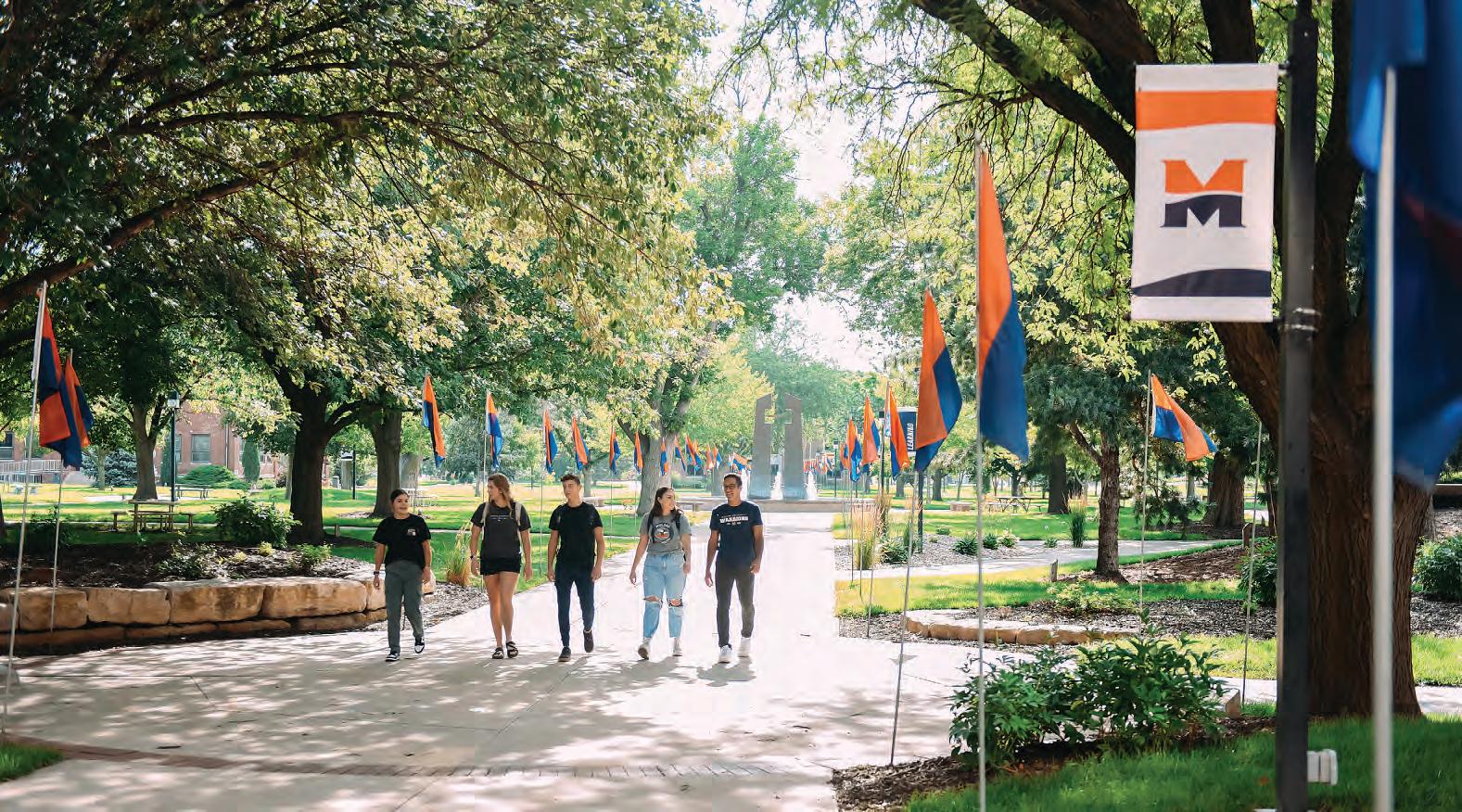





MidlandUniversity celebrates140yearsof academicsuccess
Entering its 140thyear, Midland Universit y is working tohelp studentsearn theirdegrees andsomuch more.
Midland offer s opportunities inmore than 30undergraduate academicareas,24 graduate programs, and a widerangeof professionalprogramsatboth our Fremont andOmahalocations
Midland is agateway toendless possibilities.Itscampuswill provide studentswith thesuppor t and resourcesthey need tosucceedinthe classroomandacrosscampus.
Smallclasssizesand a tight-knit campusensure that studentswill alwaysbe recognized by theirname ratherthan as a number.Students develop more than just intellectual knowledgeatMidland. With a bold andmodernapproach to a liberal artseducation, Midland offer s broadbasedlearning inmultipledisciplines with hands-onlearning tobuildindemandskills.
Featuring anenrollment ofnearly 1,600students,Midland students comefrommany different places andbackgrounds.During the202223 school year, Midlandfeatured studentsfrom39statesand25other countries,helping make itoneofthe most diversecampusesinthestate.
Midlandworks with studentsto makecollegeaffordable, as100% of Midland students receive financial aid, andscholar shipsare earned through academic , athleticand per forming artsprograms
Nearly90%ofMidland students are involvedin extracurricular activities,allowing them tobuild memoriesand relationshipsthat will lasta lifetime
Featuring thelargest athletic department inthestatewith33 varsit y spor ts,Midland allows athletestolearnfrom world-class coachesandmentor s whowill help fostersuccessboth onandoffthe field. Student-athletes competeand excelat a nationallevel.
Midland Universit y Artsguides studentsinallareasofthearts, offering education, per formance, and opportunitiesintheatre,vocal and instrumentalmusic , dance, technical


arts,ar t anddesign, andspeech anddebate Thenextgenerationof per forming artistsandleader s are
being trainedatMidland. By working fromthemarketplace back, Midland canequipstudents

MidlandUniversityOnlineoffers onlineprogramsthatfeaturea doctoraldegree,mastersdegrees, graduatedegrees,certificatesand endorsementsthatallowstudentsto maximizetheircareeropportunities.
with theskillsnecessar y tosucceed inthe world andprovide them with dynamic andinnovative learning experiencesintheir collegejourney. Inits continuedmission toinspire other s tolearnandlead inthe world with purpose, Midland Universit y graduates will be well-prepared for whateverpath they chooseafter college. Midlandfeatures a 96%
success rateamong itsgraduates, meaning that withinsixmonthsafter graduation,thosegraduates are eitheremployedor continuing their educationingraduateschool.
Inshowing itsflexibility in working tomeet studentswhereverthey are inlife, Midland Online wasintroduced inthesummerof2023, offering both graduateanddoctoralonlinelearning in a widerangeofprograms
Inadditiontothetraditionaloncampusundergraduateoffering s, Midland Universit y Onlineoffer s 24 onlineprogramsthatfeaturea doctoraldegree, master s degrees, graduatedegrees,certificatesand endorsementsthat will allow students toadvance theircareers.
When studentsjoin the Warrior family, they becomepar t ofanopenminded, purpose-driven,problemsolvingcommunity.
Thefuture islimitlessatMidland Universit y.
To learnmore aboutMidland Universit y, visitMidlandu.edu

Schedule your college visit for a time when students are on campus to get a better feel for the school.
JACQUIE BUTLER
EducationQuest
Juniors, it’s time to get serious about planning for college. Some important tasks you can knock out this year include taking the ACT, doing some job shadowing in your anticipated field of study, setting up a ScholarshipQuest account to begin searching for scholarships, and going on campus visits.
Spring of your junior year is the ideal time to go on campus visits. Taking your campus visits prior to your senior year will help you to begin narrowing down your list of potential colleges.
Try to visit while classes are in session rather than on the weekends or during a school break. This will allow you to peek in on a class or two to see the student-tofaculty ratio. It will also allow you to see the faces of students who attend that particular institution, and give you a real feel of the campus environment.
Colleges prefer that you schedule your tour at least two weeks prior to your desired
visit date. This will help admissions to tailor your visit toward your specific needs. For example, if you have a certain major you’re considering, they can arrange for you to meet with a faculty member or department staff. If you plan to participate in a sport, they can potentially set up a meeting with a member of the coaching staff.
If you can swing it, visit multiple colleges so you can compare them to each other and find the one that’s the right fit for you. Contact the college’s admissions office or hop on their website to schedule your visit(s).
To make your visits more effective, sit down ahead of time and write out a list of questions you’d like to have answered about each college. Your questions may be directed toward an admissions representative, financial aid counselor, faculty member, or even current students at each college. Take lots of notes and photos during your tour. You’ll be glad you did when it’s time to compare colleges and narrow your choices.
The admissions staff generally does a welcome session to begin the day. They will
then break the visitors into smaller groups, keeping parents and students together for tours. Student ambassadors will take each group and show you around campus … so expect to do a lot of walking. The tour guide will provide insight about the college, fun facts about buildings, and share information about various activities that you can participate in while attending that institution. You’ll get to check out campus housing, the student union, the fitness center, classrooms, the library, and even eat lunch in the cafeteria. This is also a great time to ask your ambassador about their college experience thus far. Make sure to get all of your questions answered before your visit concludes.
Take some time to walk around campus with your parents/guardian and chat about your day. Also, drive around the town to discover points of interest. What do you (and they) like and dislike about this college and/or community? Ask yourself if you can imagine spending the next two to four years in this environment. After all, this is a big investment and you want to make sure it’s the right fit.
Ask the admissions representative
1. What is the cost of tuition & fees, housing & food, and books?
2. What are housing options? Will I be required to live on campus? Are meal plans required?
3. What is the average class size? Are classes taught by professors or graduate assistants?
4. Are there study-abroad opportunities?
5. What kind of student services are available, such as tutoring and an oncampus health clinic?
6. How safe is campus, and what security systems are in place?
Ask the financial aid counselor
1. What applications are required for scholarships, and what are the deadlines?
2. Will scholarships from other donors affect the amount of aid I receive from the college?
3. What types of payment plans does the college offer?
Ask your student tour guide
1. Why did you select this school?
2. Are the professors accessible?
3. How easy or hard was it to get enrolled in the classes you wanted?
4. does the college have a Greek system, and how do I get involved?
5. How easy is it to get around on campus? Is there a free campus shuttle?
6. What kinds of activities, intramural sports, or clubs are popular?
Ask yourself after your campus visit
1. Was the campus the right size for me?
2. did the residence halls meet my expectations?
Whatwill youbringtothe world? Fromculinaryarts toelementaryeducation,nursingto construction, IowaWesternoffersmore academicprograms, supported byexperiencedadvisorswhowillhelp youfindtheright fit for yourgoals. Combinedwith smallclasssizes,freetutoringandcareerand transferplanningservices, everything youneedto besuccessfulcanbe foundright here.











Yourtransitionfromcollegetoacareerbeginsyourfirstsemester. Everyclass,internship,researchstudyandextracurricularactivityaddsto yourexperience.You’ll becomeyourbest self,readytogosomewhere.
Athletics.Band.Theatre.Art.Choir.Speech.Esports.Media.Experience allthethingsyouloverighthere—withascholarshiptohelpyoupayfor college.GoBroncos!
Ourblockschedule.It’sadifferencemakerthatletsyoutakejustone ortwoclassesatatime.Theresult?Studentsreportlessstress. Andprofessors?Theyseeimprovedperformance.

EDUCATIONQUEST
Federal Student Aid (FSA) is changing the Free Application for Federal Student Aid (FAFSA) for the 2024-25 academic year. The FAFSA is a student’s ticket to obtaining grants, work-study, low-interest student loans, and some scholarships. If you’re wondering if these changes will affect you and your family, the answer is: absolutely! The changes will impact everyone, including both current and future college students.
Here are the five most important things to know as of now.
The FAFSA won’t open until December 2023.
Both students and parents must create a Student Aid Account to get an FSA ID before completing the form. Allow at least three days.
If parents are divorced or separated, the parent who provided the most financial support in the last calendar year will now complete the FAFSA.
The number of students a family has enrolled in college will no

longer factor into the FAFSA calculation.
The net worth of family farms and small businesses will now be required as part of the application.
Read on to learn more about each of these changes.
When will the FAFSA Open?
In the past, the FAFSA opened an-
nually on October 1. This year that won’t be the case. FSA anticipates the application opening sometime in December 2023 — no specific date yet. Because the FAFSA is required for some grant and scholarship programs, keeping track of deadlines established by colleges and other grant and scholarship providers will
be important. Who needs an FSA ID?
Both students and parents must create a Student Aid Account or FSA ID. If parents are married and file their taxes ‘married filing jointly,’ then only one parent needs an FSA ID. If parents are married and file their taxes ‘married filing separately,’ they will both need an FSA ID.
The Social Security Administration will now require verification of FSA IDs before tax information can be accessed, so applicants will need to allow at least three days for that process to occur. Students and parents must log in to the FAFSA separately to complete their respective sections.
Who provided the most financial support?
The parent who completes the FAFSA is changing for divorced or separated parents. Previously, the parent a student lived with the most in the last calendar year was included in the FAFSA. Starting with the 2024-2025 FAFSA, the
parent who provided the most financial support must complete the application.
Will changes to aid calculations impact my family?
FSA will no longer divide the Expected Family Contribution (EFC), which will soon be called the Student Aid Index (SAI), by the number of students a family has in college. What does that mean? Well, if your EFC was $20,000 last year, the amount was divided by the number of students enrolled in college – meaning if you have two children attending college, your EFC was $10,000 per student. In the future, your SAI will be $20,000 per student.
Will my family’s net worth affect my aid eligibility?
The answer is yes if your family has a farm or small business. Previously, the net worth of a family farm or a small business with fewer than 100 employees was not required. Moving forward, the net worth of each will be part of the FAFSA calculation.






NEW YORK — From $300 studded headboards and $100 coffee table books to custommade cabinets to disguise your mini-fridge, students are spending big bucks to decorate their dorm rooms, adding yet another layer to the soaring costs of college.
Some are even going so far as to hire interior designers to beautify their 12 feet by 20 feet of space.
Lesley Lachman, 18, planned her furnishings for her dorm room with her roommate immediately after deciding to attend the University of Mississippi back in May. The Rye, New York, resident scoured websites like Pinterest and designed her room herself — with hues of pink, purple and green culled from a mix of pricey brands like Essentials with Eden as well as less expensive items from Ikea and Facebook Marketplace. Total cost for the design? About $3,000, covered by her parents.
“There’s so much work that had to be done because it felt lackluster. It didn’t feel homey,” said Lachman, who posted a “before” and “after” video of her room on TikTok.
The “before” video shows stark yellow cinderblock walls, a mustard-colored builtin desk and an open closet. The “after” video shows a complete makeover, with lacey curtains to cover the closet, embroidered pillows and a cushy white headboard to dress up her bed, and customized framed art of hearts.
“I’m so in love with the room,” Lachman said after her redesign. “I want to leave the door open and want everyone to stop by and admire it.”
Overall, the back-to-college season is big
business, with families spending an average of $1,367 per person, up 14% from a year ago, according to an annual survey conducted by the National Retail Federation and market researcher Prosper Insights & Analytics. Spending on big-ticket items such as electronics and dorm furnishings as well as necessities like food accounted for more than half of the increase, NRF said. Meanwhile, the total cost of college — including tuition, fees, room and board — almost doubled between 1992 and 2022, rising from an inflation-adjusted average of $14,441 per year to $26,903 across all types of universities, according to National Center for Education Statistics, the statistical branch of


Above: the decorated dorm room of freshmen Sydney allbritton and emma Kirk features pink, green and light blue colors at the university of mississippi in Oxford, miss. Kirk, who is from Grenada, mississippi, bought a gold studded headboard, custom-made pillows and bedspread among other items for the room. Left: Students are spending big bucks to decorate their dorm rooms, adding yet another layer to the soaring costs of college.
the Education Department. Dorm costs saw a similar spike over the same time span, rising from $3,824 to $7,097.
Sara Hunt, 19, a sophomore at New York University from Pigeon Forge, Tennessee, wanted her dorm room to look cozy but her budget was $100. That’s because she’s footing 30% — or nearly $30,000 a year — of NYU’s annual college bill. Financial aid picks up the rest.


“I definitely try to work on being positive and not comparing myself to other people because I’m so lucky for what I have. But it is really stressful,” said Hunt, who worked more than 60 hours per week last school year and took a job as a pastry chef this summer to help pay for her college expenses.
For her dorm décor, Hunt scoured Goodwill stores, Dollar Tree, T.J. Maxx and Five Below for deals on neon lights, wall paper decals and beddings. She also rummaged through bins of returned items from major retailers at a discount bazaar in her hometown.
Jamel Donnor, a professor at William & Mary College in Williamsburg, Virginia, and a leading expert on inequity in education, said the big divide in dorm furnishings marks an “unspoken reality of the have and have nots.” He noted that the stark differences in dorm decorating between those who have money and those who don’t can make some students wonder if they should even be at their college.
“There’s this imposter syndrome,” he said. Dorm supplies e-tailer Dormify is playing to both ends of the budget. For the first time this fall, it’s offering various bundles of essentials including a pack of 19 items for $159 that includes bath towels and a comforter for those who are more price conscious. For the big spenders, Dormify unveiled an interior designer service for $450 with interior decorator Jen Abrams; it plans to roll out the offering with other designers next year.
Amanda Zuckerman, co-founder and president of Dormify, noted TikTok has raised the bar in dorm furnishings, creating “the ability to become TikTok famous or go viral because of how well decorated your room is.” Average orders are up 15% this fall, she said.
Dawn Thomas launched an interior design service — After Five Designs — in Jackson, Mississippi, 20 years ago for college students after designing dorm rooms for her own children who were going away to school. She said in the past few years, she has seen plenty of other designers now working with students.
Thomas noted parents spend as much as $10,000. One of the more popular items is a custom-made $1,900 cabinet that covers the refrigerator in the dorm.
But she’s also noticing parents are starting to hold back on certain items.
“The economy hasn’t been that great this year,” she said. “And I’ve noticed the sky is not the limit.”
Emma Kirk, who is from Grenada, Mississippi, and a freshman at University of Mis-
sissippi, tapped into Thomas’s services and bought a gold studded headboard, custommade pillows and bedspread among other items. She didn’t know what the total bill was since her parents paid for it. But she said her parents reined her in whenever she picked out something too expensive.
“(Thomas) would work out something where we could get something similar,” she said.
Even on her tight budget, Hunt — the NYU student — says she is happy with her dorm room décor.
“At NYU, so many parents pay for everything. But I’m not here to judge,” she said.
“The truth is, even if I had all the money in the world, I probably would still decorate my room the way that I have it now.”
Narrow your college choices during your junior year so you’ll be prepared to apply for college and financial aid early in the fall of your senior year.
Answer the following questions to determine which schools might be the best fit:
What do you want to study?
If you know what you want to study, research colleges that offer degree programs in that area. If you don’t know, it’s OK. Many students begin college “undeclared,” and some start at a community college and then transfer to a four-year school.
What kind of school do you want to attend?
Do you prefer a large university or

Consider the overall cost of college: tuition and fees, room and board, books, transportation costs, and personal expenses. Determine what you and your parents can afford to pay out-of-pocket and plan to apply for financial aid to help make up the difference. Calculate the loan debt your family may need to incur for your college education.
Don’t limit your search to familiar institutions. Just because your parents or siblings went to a certain college doesn’t mean it’s the right fit for you.
Don’t limit your search to colleges you think you can afford. The more expensive the school, the more financial aid you may be eligible to receive. Wait until you receive financial aid award notifications to determine which school is the most affordable.
a small college? Are you interested in a community college? What kind of student/teacher ratio do you prefer? Choose a college that will
enhance your overall collegiate experience, while providing you with the academics necessary to receive your desired degree.
Do you want to live close to home and commute? Do you want to be in a large city or a small town? How big of a factor is out-of-state or private college tuition? If you want to go out of state, investigate reciprocity programs such as the Midwest Student Exchange Program.




Don’t choose a college just because it’s near your boyfriend or girlfriend. The school may not be a good match for you — and he or she may not be either!
Don’t insist on an out-of-state school just because you want to “get away.” Going out of state can result in higher tuition and transportation costs. Even if you attend college in your hometown, you can still “get away” by living on campus or pursuing a study abroad opportunity.




Apprenticeships and trade school are alternatives to a four-year college.

Some high school seniors know exactly where they’re going after graduation… college. They’re nervous, yet excited, to start this new journey and have been planning for it for months, maybe even years. For other seniors, the choice may not be so simple; they’re wondering what their options are in the absence of going to a fouryear university/college, and that’s OK.
Here are some alternatives to the traditional college experience:
A great alternative to a four-year university is a community college, which is a school that o ers two-year programs leading to the obtainment of an Associate of Arts or Associate of Science degree. These schools have vocational programs with close ties to high schools, community groups, and employers in their local community. Attending a community college can earn academic credit towards a bachelor’s degree, and can help lower
costs of overall education expenses, as the programs themselves are generally less expensive.
Online education is all the rage now, and is ever-changing year after year. The reasons for its growing popularity include: self-paced, cost-e ective, and locationindependent learning; all of which can help a student grow both professionally and personally. This is also a great option for single parents, students with disabilities, and situations where travel can be di cult.
Gap years are a semester or year of learning by experience, which is typically taken immediately after high school graduation, but prior to college education. The main objective of taking a gap year is to engage a student’s professional, practical and personal awareness, by fi nding the right balance between independence and support. The end result is the student will have a better grasp on what they want to study,
thereby increasing future odds of higher learning and earning potential.
For many high school graduates, trade school o ers a more a ordable and secure path to career entry and professional development than a traditional four-year university. Trade schools focus on specialized job training in high-demand fi elds, assisting students in fi nding gainful employment in a much quicker timeframe than a college can. Programs normally range from eight weeks to two years depending on whether you want to earn a certifi cate, diploma or associate degree. Graduates may then go on to sit for licensing exams, become apprentices or seek immediate employment.
Apprenticeship is an industry-driven, high-quality career pathway where employers can develop and prepare their future workforce, and individuals can obtain paid work experience, classroom instruc-

tion, and a nationally-recognized credential. Through a registered apprenticeship program, you can obtain paid, relevant work experience while acquiring the skills and credentials that employers value.
Enlisting in the military prior to attending college is a good way to instill focus and discipline before taking college-level courses. The military places great importance on gaining knowledge through studying, which is the main reason that individuals often come out of basic training as better students. The military also provides many options to help pay for college that can either eliminate or lower the cost of tuition.
In short, it’s perfectly fi ne to explore other options versus going straight to a four-year university right after graduation. That type of educational environment isn’t for everyone, and it doesn’t have to be. Keep your vision in mind, and head toward that goal, regardless of how you get there.




You know you deserve that college scholarship, not to mention admission to the university you want to attend. But the people who sit on scholarship and admissions committees don’t.
the site says.
• Two15-weeksemesters(contactusforcurrentschedule)
• Threeeveningsperweekfrom5-8p.m.(Monday,Wednesday&Thursday)
• Sixhoursofinstructionplusthreehoursofsupport&integrationperweek
• Cost:$1,200persemester(allbooks&materialswillbeprovided)
• Scholarshipsavailable
• In-person&onlineenrollment(Classsizesarelimited)
• Post-graduationmentoringandcoaching

That’s where letters of recommendation can give you an edge. And in some cases, they are required.
“The main objective is to help us understand better the context of the academic experience and the true character of the student applying,” said Sarah Richardson, assistant vice provost for enrollment management at Creighton University.
Most academic scholarships require letters of recommendation for a student to be considered, according to Scholarship Prowl. Another site, College Raptor, says scholarship committees want to see how wellrounded a student is; it’s about more than academics, though grades are important.
Letters of recommendation “provide a view into their relationships and connections with their teachers, the school and their community. Since you’re often choosing a professional you’re close with to write the letter, the recommendation will reflect on your own professionalism, respect for others and actions in the classroom. It’s a testament to how you treat and get along with faculty members as well as your peers,”
It’s important to have a strong relationship with your teachers, it adds. Don’t ask a teacher you don’t know well to write a letter of recommendation. Instead, ask a former teacher you are close with to say a good word about you. A coach is a great choice as well, since a student might spend a lot of time playing a particular sport. Athletics are a great avenue for learning and demonstrating leadership skills, among other strong suits.
“If you have a teacher who knows you as accountable, honest or a pleasure to have in class, this is one you’ll want to pursue for your letter,” College Raptor says.
Letters of recommendation give admissions officers insight into a student’s character, which goes beyond grades or test scores. Such letters, in a nutshell, should highlight the student’s accomplishments as well as their potential for success.
“Letters of recommendation are an important part of our holistic review of the student application,” Richardson said. “These letters can often put into context the high school record and the intangible pieces of what makes a student a good fit for the institution. We look to admit students who are not only very strong academically, but also possess the ability to work hard and over come challenges.”
Here’s what you should know about student loans

Associated Press
If you’re heading to college or starting to think about where you’d like to apply, you’re probably considering options for funding your education. If you need to borrow money to pursue your dreams, you are far from alone.
According to the Federal Reserve, 30% of all U.S. adults said they incurred at least some debt for their education. Borrowers owe a collective $1.77 trillion in student loan debt, including federal and private loans.
“Borrowing is almost at the point where it’s a requirement,” said Dana Kelly, from the National Association of Student Financial Aid Administrators.
If you’re a high school senior or a college student, you’ll want to apply for federal student loans through the Free Application for Federal Student Aid, also known as FAFSA, in December for the 2024-2025 school year. For private student loans, you can apply whenever you need the loan.
When you take out student loans, it’s beneficial have to have an idea of what professional field you want to pursue, calculate how much you need to borrow, and understand the basics of loan interest. If this sound like a lot, don’t worry — we’ll break it down for you. Here’s what you need to know.
The first step is to fill out the FAFSA. You will have to answer questions about your family’s financial contribution, along with other questions that will help determine if you qualify for federal or state financial aid and which loans you can apply for. You’ll fill out the application each year.
Cathy Mueller, executive director of Mapping Your Future, a nonprofit that helps people navigate higher education, recommends exhausting every possible funding option to reduce the amount you need to borrow.
As you fill out the FAFSA, Mueller recommends that you estimate the amount you will need to borrow for your entire college career, but also be realistic about what you will be able to pay back.
A tool that can help is the debt/ salary wizard from Mapping Your Future, an interactive calculator that helps determine how much you can borrow based on your estimated future earnings.
In previous years, the FAFSA opened on Oct. 1. This year, the government is making big changes and the application will be available in December, but the date has
over the life of the loan,” Kelly said. Private loans come with a different set of requisites and application process.
There are several different federal student loan options: direct subsidized loans, direct unsubsidized loans, direct PLUS loans and direct consolidation loans. But the most common are direct subsidized and unsubsidized loans, which are taken by the person who is completing the college degree.
university or elsewhere.
If you meet with a counselor, it’s good practice to come with prepared questions about repayment programs for when you need to start paying back your loan. Good questions to ask yourself or a counselor, according to Kelly, include:
1. If I get this amount of a loan as a freshman, is that rate going to be flat over my four years? Or do you anticipate that I’m going to need to borrow more each year?
2. Does my opportunity for scholarships go up so the amount I need to borrow can come down?
not yet been announced.
Once the application is open, you need to check your state’s deadline to apply for state financial aid. Since financial aid is firstcome, first-served, you’ll want to apply as soon as you can to qualify for both federal and state grants.
For private student loans, the timeline looks different. Private lenders require you to have proof of enrollment, so experts recommend you apply a couple of months before your tuition is due.
Federal student loans are backed by the government and private loans come from banks, credit unions or other private institutions.
In general, federal student loans offer lower interest rates and more opportunities for affordable repayment plans, such as the Public Service Forgiveness Plan or the various income-driven repayment plans.
Kelly recommends that students try to only use federal student loans, though there are borrowing limits.
“More than likely, private loans are going to cost a student more
Subsidized loans have their interest covered by the government and are granted to students with demonstrated financial need. Subsidized loans have their interest covered while you’re in school at least half-time, for six months after you graduate and if you qualify for deferment, which allows you to stop making payments temporarily. Unsubsidized loans are available to most students, but they are responsible for paying the interest.
Student loans must be paid back with interest, which is additional money that you pay for borrowing. The interest on your student loan depends on your type of loan and when your loan was made available for you to use for the first time.
If your loan is disbursed on or after July 1, 2023, but before July 1, 2024, you will have a fixed interest rate of 5.5%.
Before you accept your student loan offer, regardless if it’s federal or private, you want to make sure you understand the details, said Betsy Mayotte, president of The Institute of Student Loan Advisors. Those include when interest accrues, if interest is capitalized and if there are any late fees.
If reading the details on your own feels daunting, Mayotte recommends speaking with a financial aid counselor, either at your
If you are taking out federal student loans, it’s a requirement that you complete an entrance counseling course. Kelly recommends that you pay extra attention to this process and not rush through it.
If you have specific questions about your student loans, there are many resources available. You can visit the Federal Student Aid website or reach out to your college’s financial aid office or community or non-profit organizations such as Mapping Your Future.
Mueller recommends that you keep track of how much you are borrowing each year so you have an idea of how much you will owe by the end of your college career and how much your monthly payments will be.
Mueller also recommends that, if you are working during college, you consider paying some of the interest that accumulates each year.
“You’re not required to make those interest-only payments. But if you do, you’re saving yourself money in the long run,” Mueller said.
Interest payments while you are still in college are generally low, but they get capitalized once you’ve graduated or left school, which means your loan gets larger and you would be paying interest on the interest, said Mueller.




• First in thenationtooffer academicresources via SuccessHubprofessionalstaffinfirst-yearresidencehalls
• Mostcomprehensivepre-professionalscholars advisingandguaranteeprogramintheU.S.
• 99%ofrecentgradsareemployed,pursuinganadvanced degreeorparticipatinginservicewithin6months